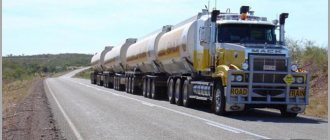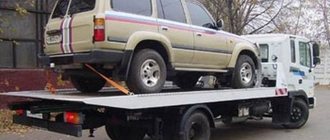Fines for overloading freight transport in 2021
Background
It was there that the issue of controlling the overload of freight transport along the axles was worked out and, of course, the practice of collecting huge fines associated with damage to the road infrastructure (roadbed) of the Russian Federation was developed. It is estimated that about 20% of freight vehicles are overloaded, causing damage to the road surface.
The vehicle overload is determined by the load on each axle: rear plus front. The total is the load of the vehicle's weight transmitted through the wheels to the road surface. Often the rear axle of a car bears more of the load compared to the front.
In most cases, permitting documentation for reloading is not issued. Accordingly, damage caused to roads is not compensated. At the same time, drivers often do not know about the overload, since shippers indicate underestimated data in the consignment note.
Statistics have confirmed the effectiveness of introducing fines for overloading
Every month, from 100 to 200 thousand violations of weight and size standards for trucks are recorded, which leads to billions of losses for the state and taxpayers. In particular, in 2021, more than 20 bridges were damaged by destroying trucks on federal highways. The restoration of each of these objects will take 1.5-2 years.
Since the fine for overloading was introduced, the number of violations of traffic rules has decreased by 2.5 times. If things continue like this, at this rate, then over time, congestion on the roads may become a rare occurrence, and their quality will improve significantly.
What contributed to the reduction of such offenses, as well as:
- Reduced the likelihood of accidents because lengthening the braking distance leads to an accident. Note that the braking distance is lengthened by the inertia of the load and creates a greater likelihood of the car skidding, which is inevitable in rainy weather and ice. And if the load is not secured, then there is a danger of tipping over and then other road users will also suffer.
- Extended the service life of highways, especially in terms of increasing the service life of the road before rutting. The problem of rutting has worsened in recent years due to the rapid increase in traffic intensity, as well as abnormal temperatures in the summer.
- Overload leads to increased wear of vehicle parts and components, and also increases fuel and oil consumption.
You can figure out the problem yourself by reading the article to the end to find out how much the fine is for overloading, or use the services of our company.
How are fines for overloading issued?
In 2021 there are 3 types of weight control points:
- stationary (most often located at the entrances/exits of cities),
- mobile/mobile (installed anywhere and in different places),
- automatic (overload violations are recorded automatically, and fines are sent to the owner of the truck).
For overload on axles and for overall load separately?
No. Measurement on the scales takes place along the axles, then the results of the axle measurements are summed up and the total weight of the truck with trailer is obtained.
A fine is issued in any of two cases: either there is overload on at least one axle of the car, or there is no overload on the axles, but the total weight is higher than the permissible limit.
Is there any measurement error?
Yes, there are many such errors, and they depend on the measurement technique, the type of weight control and scales.
Today, there is an established Order of the Ministry of Transport with general measurement rules, as well as instructions on the accuracy of measurements and permissible errors of scales, depending on their type and other parameters. We warn you right away, it’s a lot to read and it’s not very clear.
To make it easier for you to understand, in general cases the error is:
- 11% – on automatic scales under control when measuring along the axes of the truck,
- 5% – error in total weight at the automatic weighing point,
- 2% – any error (both overall and along axes) at stationary and mobile points (where the final fine is issued by traffic police officers).
Are there separate penalties for overweight trailer and tractor?
No. In 2021, overload is considered to be part of the vehicle. That is, regardless of whether the tractor is on the scales or its trailer, the total weight of the entire hitch as a whole is measured, as well as the weight of all the axles of the truck separately, regardless of the front or rear.
What is the fine for overload in 2021
In case of overload of more than 2% and no more than 10% on each axle and in general
- Driver of a vehicle (individual) from RUB 1,000.00 to RUB 1,500.00. (without deprivation of rights).
- Official (responsible) person from 10,000.00 to 15,000.00 rubles.
- Legal entity from 100,000.00 to 150,000.00 rubles.
- In case of automatic fixation in the amount of RUB 150,000.00.
It is important that in 2021 the Supreme Court of the Russian Federation changed the practice of imposing fines for individual entrepreneurs, recognizing the provisions of Art. 12.21.1 of the Code of Administrative Offenses of the Russian Federation is not constitutional. Read more: The Constitutional Court of the Russian Federation announced the need to reduce fines for owners of heavy trucks for overloading recorded by a camera.
In the case of more than 10% and no more than 20% for each of the axes and in general
- Driver of a vehicle (individual) from RUB 3,000.00 to RUB 4,000.00. (without deprivation of rights).
- Official (responsible) person from 25,000.00 to 30,000.00 rubles.
- Legal entity from RUB 250,000.00 to RUB 300,000.00.
- In case of automatic fixation in the amount of RUB 300,000.00.
In the case of more than 20% and no more than 50% for each of the axes and in general
- Driver of a vehicle (individual) from 5,000.00 to 10,000.00 rubles, as well as deprivation of rights from 2 to 4 months.
- Official (responsible) person from 35,000.00 to 40,000.00 rubles.
- Legal entity from RUB 350,000.00 to RUB 400,000.00.
- In case of automatic fixation in the amount of RUB 400,000.00.
In the case of more than 50% for each of the axes and in general
- Driver of a vehicle (individual) from 7,000.00 to 10,000.00 rubles, as well as deprivation of rights from 4 to 6 months.
- Official (responsible) person from 45,000.00 to 50,000.00 rubles.
- Legal entity from 400,000.00 to 500,000.00 rubles.
- In case of automatic fixation in the amount of RUB 500,000.00.
The practice of our clients shows that it is necessary to advise drivers on what and how to say, where to sign, and where to disagree. This will not only avoid fines for the company, but also the driver will avoid deprivation of his license. If the driver was charged more than 2 times under the article of the Code of Administrative Offenses of the Russian Federation regarding overloading, the court decision for the third time will be associated with deprivation of rights for at least 6 months. Such decisions are difficult to challenge on appeal, and even more so in cassation.
In some regions of Russia there are additional restrictions on overloading for the summer period; as a rule, they begin to operate from the end of May to mid-August.
If the route passes through regions of the Russian Federation, study the entire route; additional changes and restrictions are possible. The amount is determined depending on the severity of the violations, and remember! – the administrative offense will have to be eliminated in any case, and punishment cannot be avoided.
What are the fines for overloading a truck? New deprivation law
Overloading with passengers is an even more serious violation of safety regulations and in legal practice is referred to as “Extra Passenger”. In practice, this means that the driver put passengers into an extremely loaded vehicle for whom there were initially no seats, thereby putting their life and health at risk.
This applies to both public transport and civil transport. The law especially carefully monitors the transportation of children. Thus, transporting an unbelted child on your lap in an overcrowded car will also be considered overload and will be punishable by a fine. And in public transport, when organizing the transportation of a large number of children, only seats are taken into account. That is, a standing child in a crowded children's bus will cause overload.
If the driver of a passenger car uses a trailer to transport cargo, then the same requirements apply to him as to the driver of a truck. Overloading a trailer can also negatively affect the condition of the road surface, as well as lead to changes in the technical characteristics of the vehicle and loss of controllability. In this case, you can get a fine by simply passing a road sign indicating the permissible vehicle weight limit.
The amount of the fine depends on which person committed the offense (physical, legal or official) and on the actual size of the overload. The official pays more than an ordinary person, and the organization pays even more.
Amount of fine for overload for an individual:
| Overload percentage | Fine amount |
| to 10% | 1500 rubles |
| 10 — 20% | 4000 rubles |
| 20 — 50% | 10,000 rubles |
Extra passenger during transportation:
| Passenger | Transport | Fine amount |
| Adult | Public | 500 rubles |
| Adult | Private | 1000 rubles |
| Child | Any | 3000 rubles |
Penalty for overload for a legal entity:
| Overload percentage | Fine amount |
| 10% | up to 150,000 rubles |
| 10 — 20% | up to 300,000 rubles |
| 20 — 50% | up to 400,000 rubles |
For transporting an extra passenger:
| Passenger | Transport | Fine amount |
| Child | Public | 100,000 rubles |
Car weighing procedure
The procedure for determining the permissible weight of a vehicle at mobile points consists of the following key points:
- The weight of the car is determined exclusively on special equipment, namely “VA-20P” scales, corresponding to GOST-R 53228-2009.
- The measurement results should not have an error exceeding plus or minus 20 kg.
- The procedure itself must be carried out in accordance with Federal Law No. 102 “On compliance with the uniformity of measurements” and Order of the Ministry of Internal Affairs No. 1014 “List of verification means”.
How many weighing attempts
If during dynamic weighing the weight of the vehicle is overweight, the truck is stopped and sent to a stationary post for re-weighing.
During control weighing, the driver must make sure that all officials have permission and certificates for this, and that the equipment is in good condition.
What law states
The legislative framework regulating the overloading of trucks (once you figure it out, “wipe the nose of any traffic inspector”)
- Federal Law No. 257 of November 8, 2007 legislated such concepts as: overload of freight transport, permissible weight, axle load, permissible axle load, highway, highway users, indivisible cargo, etc.
- Decree of the Government of the Russian Federation No. 934 of November 16, 2009, defining the amount of damage and the rules for compensation for damage.
- Federal Law No. 127 of July 24, 1998 “On control over international road transport and liability for violation of this procedure.”
- Code of the Russian Federation “On Administrative Offenses” Art. 12.21 “Violation of the rules for the carriage of goods, rules of towing.”
- Order of the Ministry of Transport of the Russian Federation dated August 8, 1995 No. 73 determined the list of dangerous goods and the rules for their transportation.
- Decree of the Government of the Russian Federation of April 15, 2011 No. 272. Appendix 2 makes no distinction for single or dual wheels.
- Decree of the Government of the Russian Federation of January 9, 2014 No. 12, came into force on January 1, 2015.
- Codifier of meanings and types of highways.
- Codifier of the population of cities and towns.
- Codifier of types of dividing strip.
How is it determined
The maximum permissible weight of a vehicle's cargo is determined based on the ratio of its largest mass to roads of various groups. There is special equipment for accurately determining the presence of overload - an accelerometer, as well as reference books that indicate these values for each car model. To take a sample, the truck is weighed dynamically and statically, and the overload of each axle system is recorded. The errors in calculations are no more than 3%.
A traffic police inspector can check the truck and, if any faults are found, issue a fine. Most often, weighing readings are compared with the data presented in the documents for the car; if in doubt, the data can be confirmed with information from the reference book.
Maximum weight per axle
The load on the axle apparatus of a car is the pressure of the mass of the car on the surface of the roadway, transmitted from one axle (pair of wheels). The indicator is calculated using the formula:
For vehicles with two axles:
Vehicle weight = Load on front wheels + Load on rear wheels;
For three-axis:
Vehicle weight = Front axle load + Rear axle load.
Requirements for the transportation of goods in the Russian Federation
General requirements for the carriage of goods are defined in Section. 23 Traffic Rules. Thus, clause 23.1 of the Rules stipulates that the mass of the transported cargo and the load distribution along the axles should not exceed the values established by the manufacturer for a given vehicle.
When determining the values of the relevant parameters, one should proceed from the characteristics of the vehicle determined by the manufacturer, indicating:
- carrying capacity - maximum permissible weight of transported cargo a) for a passenger car, the number of seats and weight of transported cargo, depending on the number of passengers transported; b) for a bus - nominal and maximum capacity;
- curb and permissible maximum weight of the vehicle;
- distribution of curb and permitted maximum masses along the axles.
One of the most important indicators of the technical characteristics of a vehicle is the axle load value, i.e. load on the road transmitted by the wheels of a single, most loaded axle. This indicator is related to both the mass of the cargo being transported and the distribution of the payload on the vehicle.
Clause 23.2 of the Rules obliges the driver to monitor the placement, fastening and condition of the load before and during movement in order to prevent it from falling and interfering with movement. The conditions under which the carriage of cargo is permitted are also listed (clause 23.3 of the Rules).
Transportation of large, heavy and dangerous goods is carried out in accordance with special rules, liability for violation of which is provided for in Art. Art. 12.21.1 and 12.21.2 Code of Administrative Offenses of the Russian Federation.
Concepts of heavy and large vehicles
are disclosed in Art. 3 of the Federal Law “On Highways and Road Activities in the Russian Federation and on Amendments to Certain Legislative Acts of the Russian Federation”, into which they were included by Federal Law No. 248-FZ of July 13, 2015.
A heavy vehicle is understood as a vehicle whose weight with or without cargo and (or) the axle load of which exceeds the permissible weight of the vehicle and (or) the permissible axle load, which are established by the Government of the Russian Federation.
A large vehicle is a vehicle whose dimensions, with or without cargo, exceed the permissible dimensions established by the Government of the Russian Federation.
Powers and terms of issue and consideration
Protocols on these administrative offenses are drawn up by officials of internal affairs bodies (Part 1 of Article 28.3 of the Code of Administrative Offenses of the Russian Federation).
Cases of administrative offenses are considered by the head of the state road safety inspection, his deputy, the commander of a regiment (battalion, company) of the road patrol service, his deputy, and employees of the state safety inspection.
- Decisions in cases of these administrative offenses cannot be made after 2 (two) months from the date of commission of the administrative offense.
- The day of commission of these offenses should be considered the day of their discovery (suppression) by an authorized official.
- The place where the offenses under comment were committed is determined by the place where they were discovered by an authorized official.
What are the risks of overloading a truck?
Overload can have serious consequences, from failure of the vehicle's axle system to serious fatal accidents. In this case, the driver endangers not only himself, but also other road users. Unfortunately, statistics show that approximately 20% of trucks travel with cargo that exceeds their weight limits. The consequences of this can be the following troubles:
- rapid wear of the car;
- damage to the road surface;
- increasing the volume of fuels and lubricants used;
- increasing the braking distance;
- increased load on the saddle lock;
- rapid wear of automotive components, such as the brake system, clutch, car tires;
- reduced vehicle maneuverability and increased risk of rollover;
- increased risk of getting into emergency situations, increased damage and risk to the lives of participants in an accident with such a car.
How can you avoid paying a fine from your company?
To do this, you need to prove that the employee acted for personal purposes, using a car without the knowledge of the company management or Individual entrepreneurs are not a legal entity by law, so the fine must be issued to the responsible person, which is significantly less than the fine for a legal entity.
You also need to remember that at present, the movement of a heavy vehicle exceeding the permissible weight of the vehicle or the permissible load on the axle of the vehicle by no more than 2% without special permission is not administratively punishable.
Administrative liability does not arise in the case when the excess of the weight parameters of the vehicle specified in the special permit is no more than 2%.
Payment of a double fine
If you have received a decision to pay a fine under Art. 12.21.1 of the Code of Administrative Offenses of the Russian Federation, but you did not appeal the decision within the period established by law and did not pay the fine, the inspector of the State Traffic Safety Inspectorate or the State Traffic Safety Inspectorate may issue a fine of double size on the basis of Part 1 of Art. 20.25 Code of Administrative Offenses of the Russian Federation. Therefore, be careful, contact us immediately after receiving a ruling (notice) to summon you to draw up a protocol on an administrative offense under Art. 12.21.1 Code of Administrative Offenses of the Russian Federation.
What is the minimum fine in court, how much can be reduced
Clause 2.2 of Article 4.1 of the Code of Administrative Offenses of the Russian Federation allows the court to reduce the imposed fine below the lowest limit (half of the minimum amount).
Jurisdiction of administrative cases regarding transshipment
According to Art. 22 of the Civil Procedure Code of the Russian Federation, Part 2 of Art. 23.1 of the Code of Administrative Offenses of the Russian Federation, cases of administrative offenses provided for in Art. 12.21.1 of the Code of Administrative Offences, are considered by courts of general jurisdiction. At present, judicial practice in such cases can already be considered established. The vast majority of claims against carriers and shippers are satisfied in full by the courts. Appealing such decisions does not lead to their cancellation.
At the same time, it is important to understand that the reasons for the disgusting road, lack of signs, etc. are in no way related to overloading and have no prospects in court in the event of challenging an administrative fine for overloading.
Who pays the fine for overloading and is it possible to challenge it?
If an overload is detected at the control post during weighing, a fine is issued, which is paid by the owner of the vehicle in accordance with the type of responsibility (individual, legal entity or representative).
Responsibility for paying the fine rests with the driver only because he is driving. However, this does not mean that the driver must pay the fine himself. He can be an intermediary between the person responsible for the transportation or the direct owner of the transport.
If the driver decides to pay a fine at the place where the act of overloading was created, then the owner does not have to pay it again if he receives a notice of payment of the fine as the owner of the car or legally responsible for the transportation of the cargo. In this case, you must provide a receipt for payment and challenge the notice of payment of a fine for overloading.
Regarding bribing an official for overload
(payment scheme for overloaded transport routes)
Who received the bribe
On April 20, 2021, an individual was convicted of committing crimes under Part 3 of Art.
290, part 3 art. 290, paragraph “c”, part 5, art. 290 of the Criminal Code of the Russian Federation, with the appointment of penalties: under Part 3 of Art. 290 of the Criminal Code of the Russian Federation for each of two crimes in the form of imprisonment using Art. 64 of the Criminal Code of the Russian Federation for a period of 2 years, with a fine of thirty times the amount of the bribe in the amount of 2,100,000 rubles, using Part 3 of Art. 47 of the Criminal Code of the Russian Federation, with deprivation of the right to hold positions in the public service in the system of law enforcement agencies of the Russian Federation related to the exercise of the functions of a representative of government, for a period of 2 years with deprivation on the basis of Art. 48 of the Criminal Code of the Russian Federation of the special rank “senior police lieutenant”, and under paragraph “c” of part 5 of Art. 290 of the Criminal Code of the Russian Federation in the form of imprisonment using Art. 64 of the Criminal Code of the Russian Federation for a period of 4 years, with a fine in the amount of thirty times the amount of the bribe in the amount of 13,725,000 rubles, with deprivation for a period of 2 years and 6 months of the right to hold positions in the public service in the system of law enforcement agencies of the Russian Federation related to the exercise of the functions of a representative of government , with deprivation on the basis of Art. 48 of the Criminal Code of the Russian Federation with the special rank of “senior police lieutenant”; on the basis of Parts 3 and 4 of Art. 69 of the Criminal Code of the Russian Federation, for the totality of crimes, by partial addition of the imposed punishments, K. was finally sentenced to imprisonment for a term of 5 (five) years, with his serving in a high-security correctional colony, with a fine of 15,000,000 rubles, with deprivation of the right to hold positions in the public service in the system of law enforcement agencies of the Russian Federation related to the exercise of the functions of a representative of government, for a period of 3 years, with deprivation of the special rank of “senior police lieutenant.” The individual was found guilty by the indicated verdict of receiving a bribe twice, i.e. an official personally receiving a bribe in the form of money, in a significant amount, for committing illegal actions in favor of the briber and, by virtue of his official position, facilitating such actions, and was also found guilty of receiving a bribe, i.e. receipt by an official of a personal bribe in the form of money in a large amount for committing illegal actions in favor of persons represented by the bribe-giver and facilitating, by virtue of his official position, such actions.
Who gave the bribe
Each was convicted of committing crimes under Part 3 of Art. 291, paragraphs “a, b”, part 4, art. 291 of the Criminal Code of the Russian Federation, with the appointment of penalties for everyone: under Part 3 of Art. 291 of the Criminal Code of the Russian Federation in the form of imprisonment for a term of 2 years, with a fine using Art. 64 of the Criminal Code of the Russian Federation in the amount of ten times the amount of the bribe in the amount of 700,000 rubles, and under paragraphs “a, b”, part 4 of Art. 291 of the Criminal Code of the Russian Federation in the form of imprisonment, using Art. 64 of the Criminal Code of the Russian Federation, for a period of 3 years, with a fine of twenty times the amount of the bribe in the amount of 9,150,000 rubles; on the basis of Parts 3 and 4 of Art. 69 of the Criminal Code of the Russian Federation for the totality of crimes, by partial addition of the imposed punishments, F... and R..., each was finally sentenced to imprisonment for a term of 4 years, to be served in a general regime correctional colony, with a fine of 9,500,000 rubles .
The crimes were committed in 2014 in the city of Moscow under circumstances detailed in the verdict. At the same time, the average size of a bribe received by a Moscow official from business representatives in 2021 increased two and a half times compared to 2015. In 2015, police recorded a similar increase, doubling the 2014 level. Against the backdrop of falling real incomes of citizens, such an increase in the welfare of corrupt officials is especially impressive, and will be even more impressive by the end of 2021.
The convicts were taken into custody in the courtroom, the verdict resolved questions about the calculation of sentences and material evidence in the case. The appeal and cassation upheld this decision.
I received a fine for overloading - how to appeal?
We have bad news for you: it is almost impossible to challenge a fine for auto fixation for overloading. But you can try, because it is free and not subject to state duties.
We have given the procedural procedure for appealing in the general relevant article. The problem with overload is that it will be difficult for you to prove the absence of this fact - especially if it is recorded by automatic filming.
But if you challenge it in court, you can apply to request documents for weight control equipment:
- instructions for the measurement (but again, here you will have to prove that the measurement performed does not comply with such instructions - a video recording is optimal for this),
- certificate of verification and verification by a judge of the corresponding mark,
- other documents provided for by this overload measuring device.
Additional penalties for overloading
1. There is also a fine for violations in the preparation of documents, which is an incorrect indication of the weight of the cargo. The difference between the weight according to documents and the weight determined by scales at the site of the administrative violation (distortion).
- Driver of a vehicle RUB 5,000.00
- Individual entrepreneur from 10,000.00 to 15,000.00 rubles.
- Legal entity from RUB 250,000.00 to RUB 400,000.00.
2. Fine for failure to comply with road signs. If there are restriction signs along the route.
- Driver of a vehicle from RUB 2,000.00 to RUB 2,500.00.
3. Judicial proceedings regarding property damage caused by vehicles transporting heavy cargo on the roads of the Russian Federation” established a procedure for compensation for damage (Government Decree No. 934 of November 16, 2009).
- According to Part 1 of Art. 1079 of the Civil Code of the Russian Federation - the obligation to compensate for damage is assigned to a legal entity or citizen who owns a source of increased danger by right of ownership, right of economic management or right of operational management or on another legal basis (by right of lease, by power of attorney for the right to drive a vehicle, by virtue of an order from the relevant authority to transfer a source of increased danger to it, etc.). In Tyumen, there is a similar unpleasant practice, according to the court ruling dated February 3, 2014 in case No. 33-431/2014, in favor of the Federal State Institution "Federal Administration of Highways "Siberia" of the Federal Road Agency" payment for the transportation of heavy cargo when traveling along for public roads of federal significance in the amount of 207,106 rubles. 30 kopecks, legal expenses in the amount of 1628 rubles. 76 kopecks, total 208,735 rubles. 06 kop.
Rules for the transportation of oversized cargo
Traffic rules (abbreviated as traffic rules) in paragraph 23.4. read: “If the load on a vehicle protrudes more than 1 meter from the rear or 40 centimeters from the sides, it must be marked with “oversized load” signs during the daytime. At night, it is necessary to additionally install white reflectors or a lantern in front, and equip the cargo with red reflectors at the rear.”
But in addition to the traffic rules, the Code of Administrative Offenses, Part 2 contains the following amendment:
“Transportation of goods that exceed the dimensions specified in the special permit, more than 10 centimeters, entails a fine of 1,500 to 400,000 rubles.”
Freight transport overload
By law, overloading or failure to comply with dimensions (exceeding) is administratively punishable, with liability ranging from a fine to deprivation of a driver’s license.
In the “realities of life”, the mass of the car is transferred to the road surface by the wheels of each axle and there are two types of load on the axle:
1. Permissible load on the transport axle determined by the manufacturer. 2. Limitation of axle load fixed by law.
The total load on the vehicle axles is the permissible load as provided by the manufacturer and required by legal restrictions.
According to the classification, freight vehicles are divided into two types:
1. cars of group A (they are allowed to be used only on tracks of the first, second and third categories); 2. cars of group B (their operation is permitted on roads of any category).
The permissible axle load for cars of group A ranges from 10 to 6 tons (depending on the distance between the axles). For a car of group B, the load can range from 6 to four and a half tons.
According to GOST R 52051-2003, the categories of vehicles intended for the transportation of goods in Russia received the following names: N1 - light-tonnage (up to 3.5 tons), N2 - medium-tonnage (more than 3.5 - up to 12 tons) and N3 - heavy-duty vehicles (over 12 t).
More information about the permissible axle load of groups A and B
| No. | Axle distance | Permissible load on axle A | Permissible load on axle B |
| 1 | Over 2 | 10 | 6 |
| 2 | 1,65-1,2 | 9 | 5,7 |
| 3 | 1,65-1,35 | 8 | 5,5 |
| 4 | 1,35-1 | 7 | 5 |
| 5 | up to 1 | 6 | 4,5 |
Appendix 1 - the weight of a single vehicle (meaning, without a trailer), during static weighing should not exceed:
18 tons for a 2-axle vehicle; 25 tons for 3 axles; 32 tons for 4-axle; 35 tons for 5 axles.
Appendix 2 - the permissible loads on the vehicle axles are indicated during dynamic weighing.
For single vehicles, with a distance between axles of 2.5 meters or more, the axle load should not exceed:
6 tons for a road designed for 6 tons; 10 tons for a road designed for 10 tons.
For reference: In European countries, higher loads are installed on transport corridors (in Poland and Germany, for example, the permitted weight of road trains is up to 40 tons, and in Slovakia - 44 tons).










